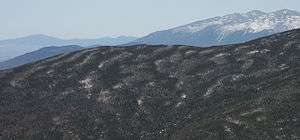Fir wave
A fir wave is a set of alternating bands of fir trees in sequential stages of development, observed in forests on exposed mountain slopes in several areas, including northeastern North America and Japan. Fir waves develop by wave-regeneration following wind disturbance, and is one of various types of patterned vegetation.

Formation
Fir waves form by the ecological process of wave-regeneration. When a tree falls, a gap in the canopy is formed. This exposes trees at the leeward edge of the gap to greater wind. These trees are thus more likely to die from damage and desiccation than windward trees. These leeward trees eventually die, gradually expanding the gap downwind. At the same time, young trees start to grow in the wind shadow in the windward portion of the gap, protected from the high winds by the surviving trees. The combination of dying trees at the leeward edge and regenerating trees at the windward edge results in the propagation of the fir waves in the direction of the predominant prevailing wind. The period of the waves is variable, typically about 60 years in Balsam Fir (Abies balsamea). One can view these from the Appalachian Trail as it ascends the Hunt Spur of Mount Katahdin in Maine. "Looking out to the Owl" and "The Brothers" are extensive areas of this phenomenon.
See also
- Temperate coniferous forests
References and further reading
- Wave-Regeneration in High Elevation Subalpine Fir Forests, from Forest and Landscape Ecology course material at Michigan Tech.
- Fir waves and life history evolution in the Adirondacks, ecological research by J. Silvertown and M. Dodd.
- Fir Waves: Regeneration in New England Conifer Forests, from Teaching Issues and Experiments in Ecology.
- Sprugel, D. G. 1976. Dynamic structure of wave-regenerated Abies balsamea forests in the north-eastern United States. Journal of Ecology 64: 889-911.
- Shibuya, M., Hagai, N., Sasaji, T., Kikuchi, S., Haruki, M., Noda, M., Takahashi, K., and Matsuda, K. 2004. Stand and self-thinning dynamics in natural Abies stands in northern Hokkaido, Japan. Ecological Research 19:301. Article abstract